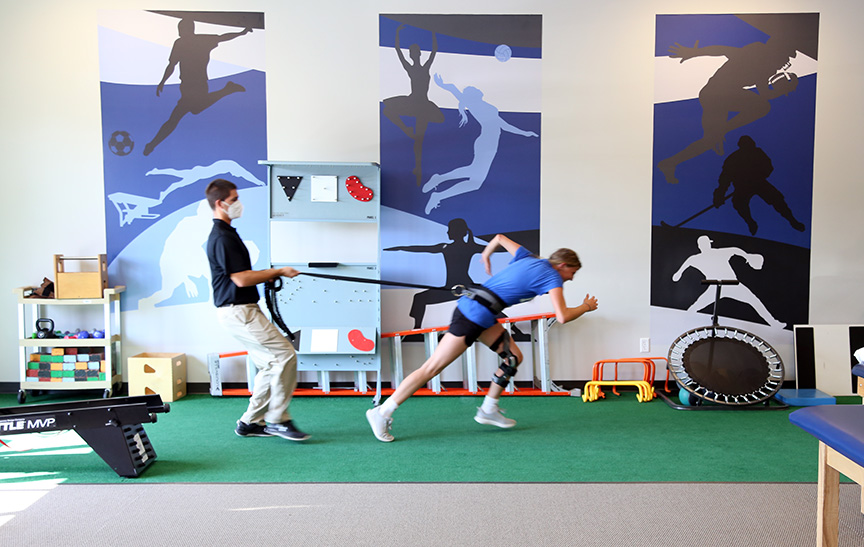News
Guide to Occupational Therapy
People can find quick solutions to their health and wellness issues, but other problems may require a more long-term solution to see improvements. If a recent injury makes it challenging to complete daily tasks, an older adult needs help getting dressed on their own or a person with a disability needs help interacting with others, a doctor may recommend occupational therapy as the solution.
People seek occupational therapy for various health reasons. This type of therapy offers different treatment techniques for various ages to help improve their daily life.
Learn more about occupational therapy and what you can expect from treatment with this guide.
What Is Occupational Therapy?
Occupational therapy is the only type of treatment that helps patients complete typical tasks they wish to accomplish throughout their lifespan. It treats various types of illness, pain, injury or disabilities that make it hard for people to work, attend school, do chores, move around, etc. This discipline assists patients by focusing on long-term health and wellness through a holistic care approach. Occupational therapy can help patients with clinical conditions by suggesting home adaptation and habit changes to continue therapy in daily routines.
Occupational therapy teaches patients how to adapt to situations and use tools known as assistive devices if necessary. Patients will work with health professionals called occupational therapists to help guide them through these specialized treatments.
An occupational therapist will evaluate patients and create individualized treatment plans to improve their daily routines. With over 130,000 occupational therapists in the United States, you can find an occupational therapist who can help improve your well-being by offering problem-solving suggestions.
Who Needs Occupational Therapy?
Many life obstacles across all ages can benefit from the help of occupational therapy. Challenges that involve development, remaining independent in your home, interacting with others in the community or transitioning back into the workforce are all reasons people may seek occupational therapy to improve their lives.
Children With Developmental Delays or Disabilities
Children may have trouble completing various activities because of developmental delays, disabilities or other challenges that can benefit from treatment.
Children might need occupational therapy because they:
- Have missed specific developmental milestones, like walking, playing skills or learning.
- Are struggling with their fine motor skills, like holding objects, coloring, practicing number and letter formation, playing with toys or using scissors.
- Are having trouble with gross motor skills, like balancing, walking upstairs and coordination.
- Do not fully understand visual processing, like recognizing letters and numbers, spacing out letters and copying shapes.
- Have difficulty using oral motor skills, like chewing food, drinking from a straw or cup, and being tired after eating.
- Lack an understanding of particular social interactions, like adapting to new environments or socializing with peers.
Recovering From an Injury
People recovering from various injuries or who experience pain in their bodies can benefit from occupational therapy. Pain or lack of feeling from an injury can impact a person’s ability to complete their regular tasks or hobbies. Common injuries that may lead to someone seeking occupational therapy include bike accidents, burn injuries, workplace injuries, dog bites, slips or falls, sports accidents and car accidents.
Reasons people should consider occupational therapy after an injury or because of pain include:
- Regaining full movement in extremities to complete typical tasks, sports, workouts and other activities.
- Improving the recovery process after an injury.
Maintaining Motor Skills as an Older Adult
Retaining motor skills as people age is a crucial part of continuing to participate in the activities they are passionate about. Occupational therapy can keep movement an essential part of an older adult’s day, so they can keep enjoying favorite hobbies or get back into the activities they used to love.
Some of the reasons older adults may need occupational therapy include:
- Having trouble measuring ingredients for baking or cooking.
- Lacking the strength to hold items like bags, cameras or groceries.
Recovery From a Brain Injury
The recovery process after a traumatic brain injury is a complex journey. The primary reason for occupational therapy after a brain injury is to help a patient regain prior skills and abilities to achieve new levels of independence. Brain injuries can impact various functions, including physical, psychological and cognitive. Occupational therapists will use their problem-solving skills to find ways to engage with their patients and help them improve in any of those areas.
Occupational therapy is helpful for people recovering from traumatic brain injuries so they can learn new ways to adapt. These life skills can include learning how to complete daily tasks like self-care, managing their home and interacting with people.
Maintaining Independence
Some individuals have chronic conditions that hinder their ability to maintain their independence. People who want to avoid moving to an assisted living facility and keep living comfortably in their homes seek out occupational therapy to find ways to adapt to their condition and maintain independence.
Reasons a person may consider occupational therapy for their independence include:
- Being unable to complete necessary household tasks, like retrieving the remote for the TV, cooking meals, taking a shower and moving around the house.
- Worrying about their safety alone at home.
- Wanting to improve their quality of life at home.
Functioning in the Community
Individuals who lack the skills to function adequately in public can use occupational therapy to adjust to this transition. An occupational therapist can teach daily life skills to people who want to venture back out into their communities.
Some reasons a person should seek occupational therapy to get more involved in their communities include:
- Needing help learning how to order meals at a restaurant.
- Having trouble counting money for a cash transaction.
- Needing help managing social skills in a public place.
Going Back to Work
People need assistance getting back into the workforce for numerous reasons. This transition can be difficult for people who have been out of work for a long time, and occupational therapists can provide treatments that prepare people for getting a job.
Some reasons a person would need occupational therapy for transitioning into the workforce include:
- Returning to work after time off because of illness or injury.
- Returning to work after homelessness or substance use treatment.
Common Goals With Occupational Therapy
Across every reason a person may need occupational therapy, there are numerous shared goals, all of which revolve around maintaining independence and enjoying a better quality of life. People of any age can set similar aims when they go through occupational therapy.
The common goals for occupational therapy include the following.
- Eating: The process of eating requires fine motor skills, which is something you may struggle with due to age, injury or other factors. Many people go to occupational therapy to develop coordination and strength.
- Grooming: Another activity that requires fine motor skills is grooming. Tasks like brushing hair, brushing teeth, putting on makeup, applying deodorant and tweezing eyebrows all require strength in the hands. Occupational therapy for grooming can help individuals become more independent.
- Handwriting: Striving for neat handwriting is a typical goal for occupational therapy patients, especially for children with fine motor skill challenges. This goal requires coordination and practice, like writing in a journal.
- Getting dressed: Dressing yourself requires many fine motor skills and is a top goal for patients of any age. Things like using zippers, securing buttons or tying shoes are all tasks that occupational therapy for dressing can benefit.
- Daily skills: Accomplishing daily skills like making the bed, making meals in the kitchen, turning on lights or cleaning up after themselves are all tasks that can be challenging for people. Occupational therapy for daily skills can help develop motor skills to complete these tasks or find new ways to adapt a person’s abilities to the situation.
- Bathing: Taking a bath or shower are two tasks people may need help adapting to after an injury or because of motor skill development.
- Socializing: Developmentally delayed individuals or people living with disabilities may need help improving their social skills. Things like reacting to good or bad news, ending a conversation or communicating nonverbally are all things people can learn from occupational therapy.
- Cognitive skills: Cognitive function after brain injuries can range in severity, and occupational therapy can help these patients develop skills essential to improving their lives and independence.
5 Things to Expect With Occupational Therapy 
Starting the occupational therapy journey looks similar for all patients. The occupational therapist must begin by evaluating their patient and learning about their problems, goals and other obstacles that impact their life. These evaluations can be a short conversation or a longer process. The patient’s age, injury or unique circumstances can affect the interview process’ duration and setup.
Patients who understand what to expect in occupational therapy may have an easier time advocating for themselves during the evaluation process and better communicate their treatment objectives.
Here are some of the things you can expect in occupational therapy.
1. Patient Interview
The first thing an occupational therapist may review during the initial evaluation is your medical records, which helps them understand your health history and current status. The rest of the interview will fill in other essential information that will help create an occupational therapy plan, including:
- Patient’s age
- Referring primary care physician
- Reason for referral
- Patient diagnosis
- Necessary precautions
The occupational therapist will also ask questions about your daily routine currently or before the injury occurred. This general information will set the foundation of the treatment plan and help create a safe discharge after you complete therapy.
2. Assessment
After the initial patient interview, the occupational therapist will administer an assessment to understand more information about your health, injury diagnosis or other factors that contribute to your need for occupational therapy. Some aspects they’ll inspect include:
- Mental health
- Pain levels
- Vital signs
- Muscle tests
- Range of motion
- Coordination and balance
- Physical feeling
- Assistance needs
- Skin health
- Fine motor skills
- Gross motor skills
- Sensory processing
An occupational therapist can perform various tests depending on your specific health needs. The assessment varies depending on the injury you are recovering from, your age and what you want to improve in occupational therapy.
3. Setting Goals
After the evaluation and assessment process, the occupational therapist will determine the type of treatment that will benefit you most and discuss goals for therapy. The recommended objectives will be measurable and connect with the original referral for occupational therapy treatment.
An example of an occupational therapy goal includes:
- During the first month of occupational therapy, I will achieve getting dressed on my own.
Setting goals and sticking to them is an essential part of occupational therapy. A vital motivator of occupational therapy is working toward these goals and having a yardstick for success.
4. Develop a Plan
Having completed every step from the initial evaluation and learned all about the client’s goals for occupational therapy, the occupational therapist will start creating a plan to help meet or exceed every goal the patient sets.
This plan will outline the duration of the occupational therapy treatment and the number of sessions the patient will have to complete. It will also describe strategies for improving the client’s quality of life.
Finally, the occupational therapy plan will outline whether you will go to an office for treatments, or if an occupational therapist or OT assistant will visit your home to provide treatment. Every plan is unique and aims to assist you in the most effective way possible.
5. Use Resources to Help Yourself
Another aspect of occupational therapy is providing patients with the resources and tools to help themselves improve outside treatment sessions. Recovery should be a continual process, and patients who understand various exercises and modifications to continue their daily routines can take a more active role in their occupational therapy treatment process.
Occupational therapy can help patients understand their problems or pain and develop new ways to cope or manage these problems. Having more control over pain helps patients have more confidence in their movement and tackle their days with better attitudes.
How to Get Started With Occupational Therapy
Your life can change seemingly in an instant. If you’ve found your typical daily tasks are challenging to accomplish and you want to improve, getting started with occupational therapy can be simple. Find quality occupational therapy services that can help you restore function, improve your living abilities and get you back into your community.


